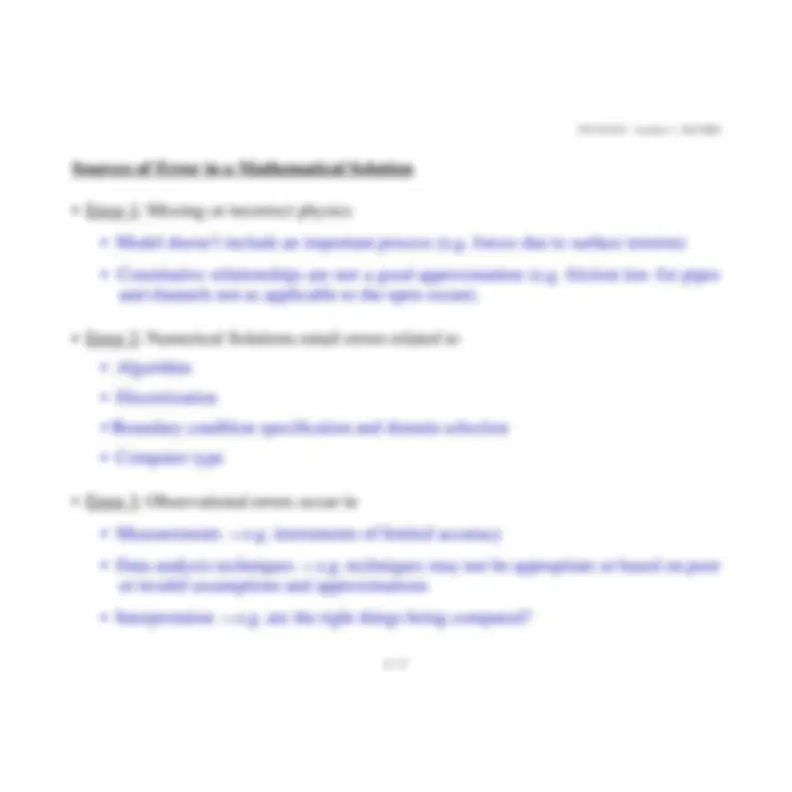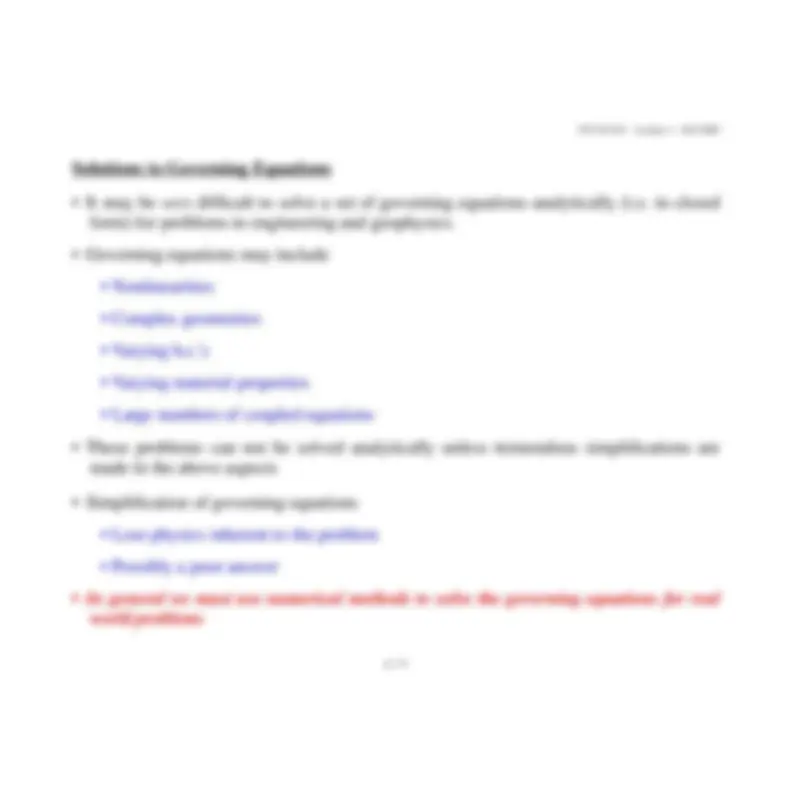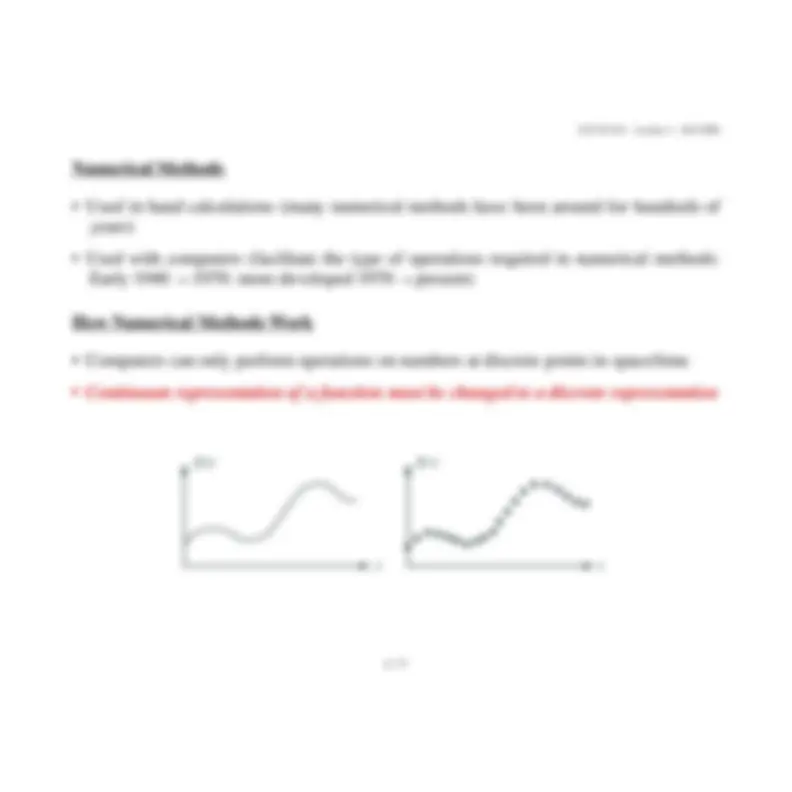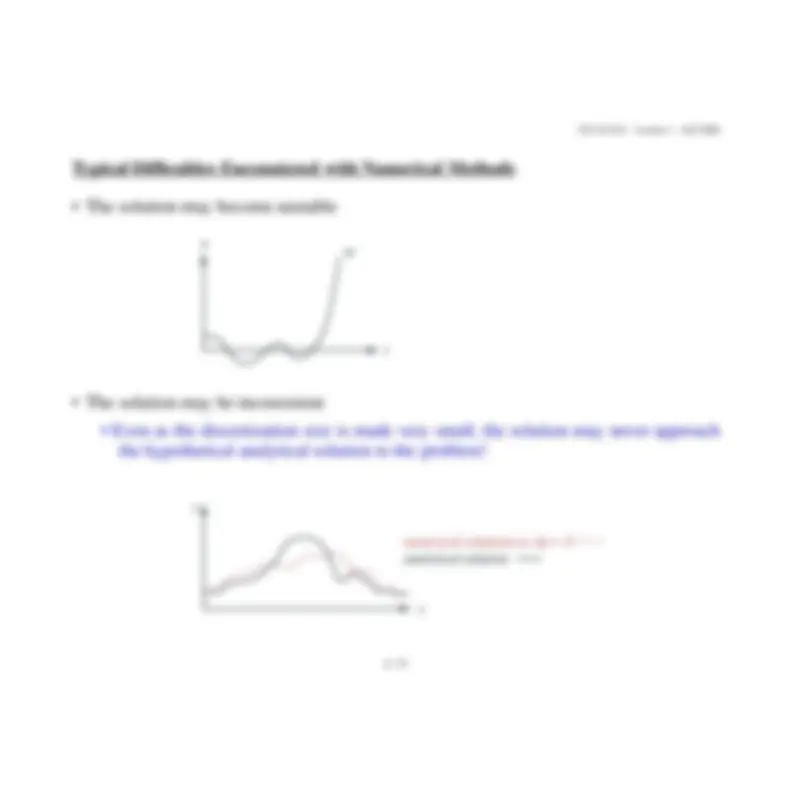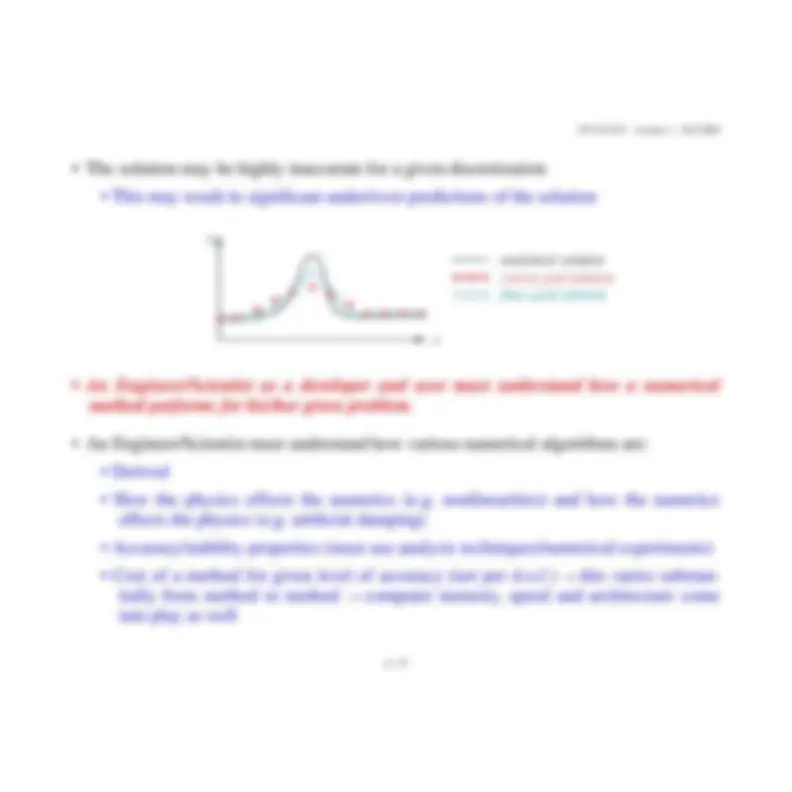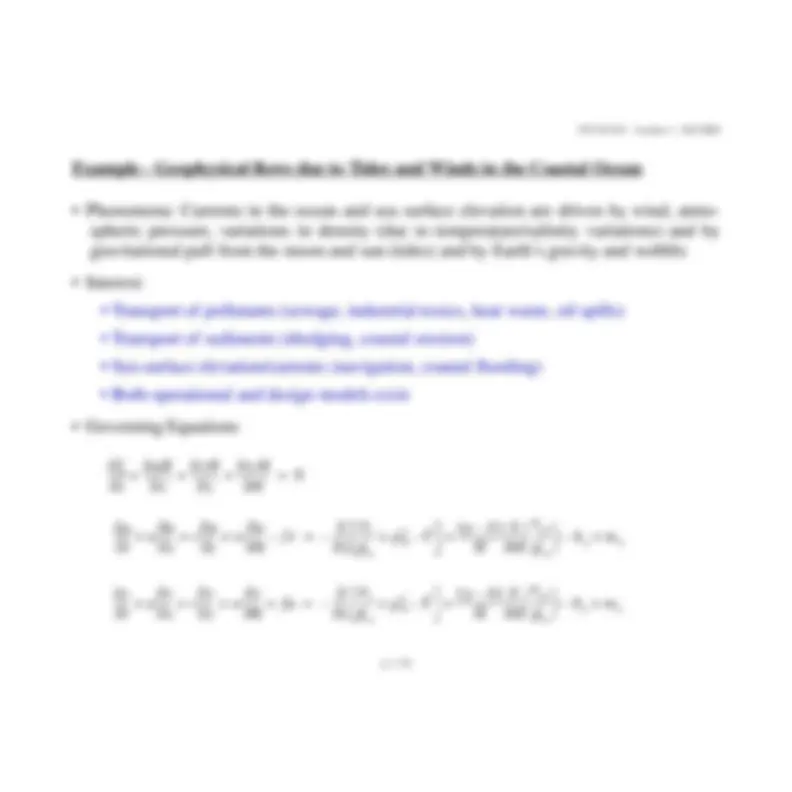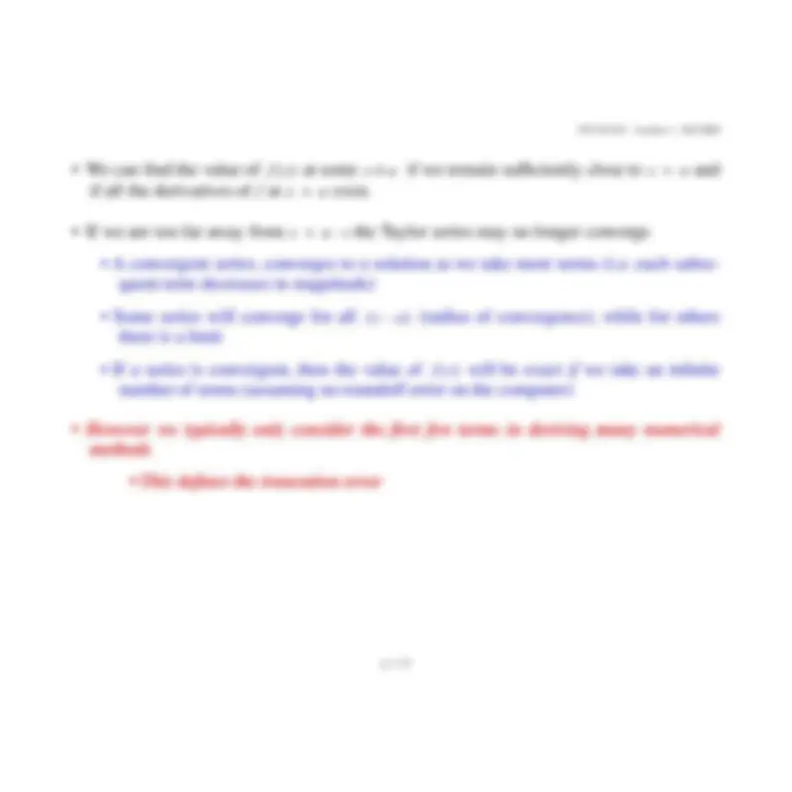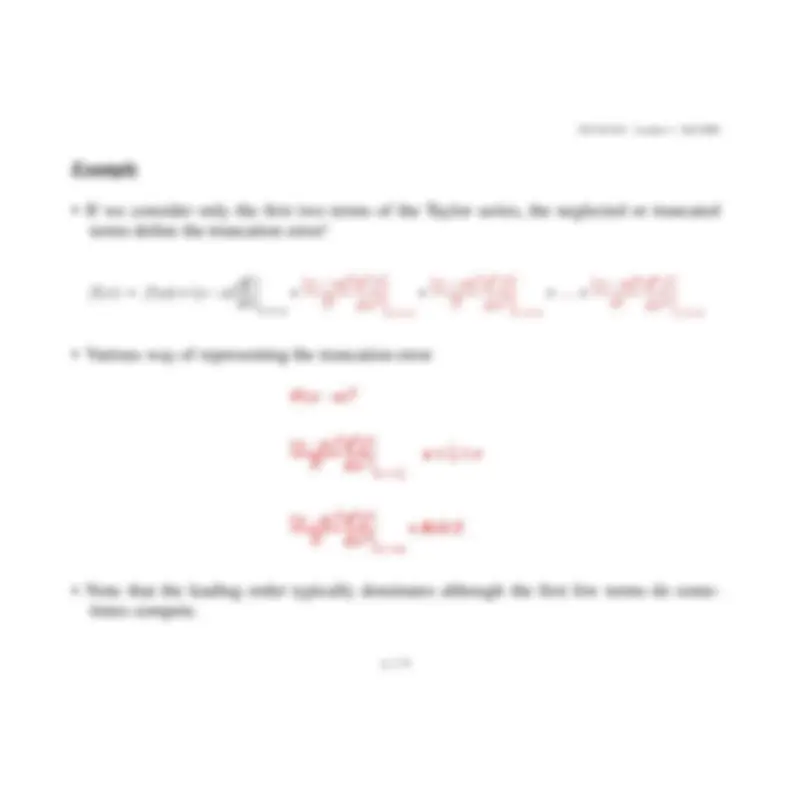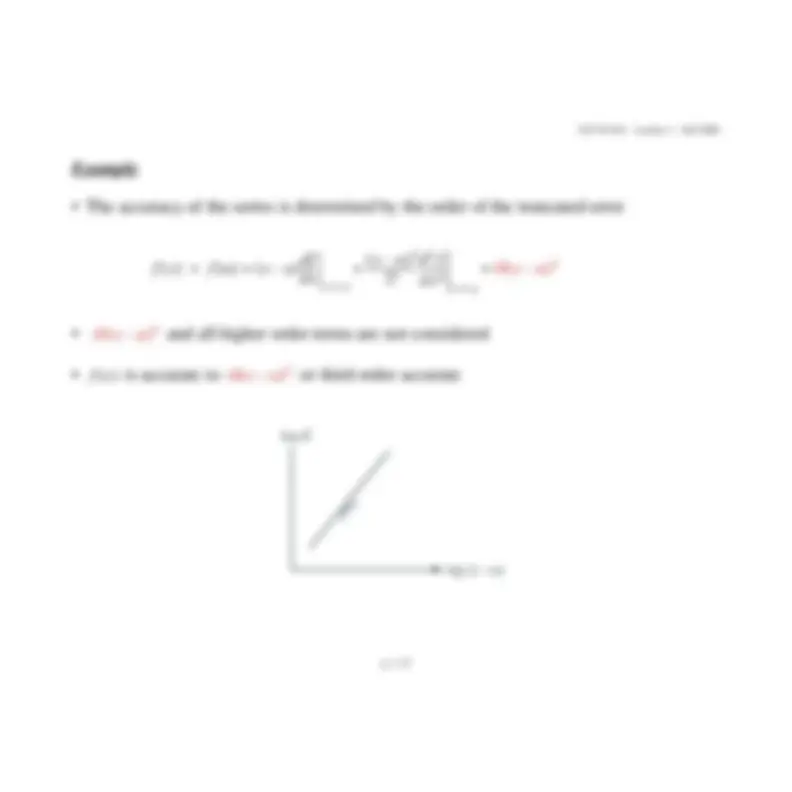Download Numerical Analysis in Engineering: Constitutive Relationships and Solution Errors and more Slides Numerical Methods in Engineering in PDF only on Docsity!
CE 341/441 - Lecture 1 - Fall 2004
p. 1.
LECTURE 1INTRODUCTIONFormulating a “Mathematical” Model versus a Physical Model • Formulate the fundamental conservation laws to mathematically describe what is physi-
cally occurring. Also define the necessary constitutive relationships (relate variablesbased
on
observations)
and
boundary
conditions
(b.c.’s)
and/or
compatibility
constraints.
- Use the laws of physics applied to an object/domain to develop the governing equations.
- Algebraic equations• Integral equations
→
valid for the domain as a whole
→
valid at every point within the domain
- e.g. Newton’s 2nd law applied to a point in a hypothetical continuum
→
Navier-
Stokes equations
- Solve the resulting equations using
- Analytical solutions• Numerical or discrete solutions
- Verify how well you have solved the problem by comparing to measurements
CE 341/441 - Lecture 1 - Fall 2004
p. 1.
INSERT FIGURE NO. 115
Physical System
Numerical Solution
Governing Equations
Nature
Numbers
Set of Mathematical Equations
ERROR 1: Formulation Error
ERROR 3: Data Errors
ERROR 2: Numerical Errors
Engineering modelers should distinguish Formulation Errors,Numerical Discretization Errors and Data Errors
A MATHEMATICAL MODEL
CE 341/441 - Lecture 1 - Fall 2004
p. 1.
Solutions to Governing Equations • It may be
very
difficult to solve a set of governing equations analytically (i.e. in closed
form) for problems in engineering and geophysics.
- Governing equations may include
- Nonlinearities• Complex geometries• Varying b.c.’s• Varying material properties• Large numbers of coupled equations
- These problems can not be solved analytically unless tremendous simplifications are
made in the above aspects
- Simplification of governing equations
- Lose physics inherent to the problem• Possibly a poor answer - In general we must use numerical methods to solve the governing equations for real
world problems
CE 341/441 - Lecture 1 - Fall 2004
p. 1.
Numerical Methods • Used in hand calculations (many numerical methods have been around for hundreds of
years)
- Used with computers (facilitate the type of operations required in numerical methods:
Early 1940
→
1970: more developed 1970
→
present)
How Numerical Methods Work • Computers can only perform operations on numbers at discrete points in space/time • Continuum representation of a function must be changed to a discrete representationINSERT FIGURE NO. 116
f(x)
f(x)
x
x
CE 341/441 - Lecture 1 - Fall 2004
p. 1.
Why Study Numerical Methods • No numerical method is completely trouble free in all situations!
- How should I choose/use an algorithm to get trouble free and accurate answers?
- No numerical method is error free!
- What level of error/accuracy do I have the
way
I’m solving the problem?
→
Identify
error 2! (e.g. movement of a building)
- No numerical method is optimal for all types/forms of an equation!
- Efficiency varies by orders of magnitude!!!
- One algorithm for a specific problem
→
seconds to solve on a computer
- Another algorithm for the same problem
→
decades to solve on the same
computer
- In order to solve a physical problem numerically, you must understand the behavior
of the numerical methods used as well as the physics of the problem
CE 341/441 - Lecture 1 - Fall 2004
p. 1.
Typical Difficulties Encountered with Numerical Methods • The solution may become unstable^ INSERT FIGURE NO. 117 • The solution may be inconsistent
- Even as the discretization size is made very small, the solution may never approach
the hypothetical analytical solution to the problem!
INSERT FIGURE NO. 118
u
t
8
c
x numerical solutions as
∆
x
0
analytical solution
CE 341/441 - Lecture 1 - Fall 2004
p. 1.
Example - Geophysical flows due to Tides and Winds in the Coastal Ocean • Phenomena: Currents in the ocean and sea surface elevation are driven by wind, atmo-
spheric pressure, variations in density (due to temperature/salinity variations) and bygravitational pull from the moon and sun (tides) and by Earth’s gravity and wobble
- Interest:
- Transport of pollutants (sewage, industrial toxics, heat waste, oil spills)• Transport of sediments (dredging, coastal erosion)• Sea surface elevation/currents (navigation, coastal flooding)• Both operational and design models exist
∂ζ∂
t
-^
uH ∂
x
vH ∂
y
wH ∂σ
u ∂
t
-^
u
u ∂
x
-^
v
u ∂
y
-^
w
u ------ ∂σ
fv
∂ -----∂ x
-^
p
s ρ
o
-^
g
ζ
a
b
(^
H
------∂σ
τ
zx ρ
o
b
x
m
x
v ∂
t
u
v ∂
x
v
v ∂
y
w
v ------ ∂σ
fu
∂ -----∂ y
p
s ρ
o
g
ζ
a
b
(
H
∂ ------∂σ
τ
zy ρ
o
b
y
m
y
CE 341/441 - Lecture 1 - Fall 2004
p. 1.
p ------ ∂σ
ρ
gH a
b
(^
m
x
σ
(^1) ρ o
∂τ
xx ∂
x
σ
∂τ
yx ∂
y
σ
a
b
(^
H
ρ
o
∂ζ∂ x
σ
σ
a
(
a
b
(^
-^
H
x
σ
∂τ
xx ---------^ ∂σ
∂ζ∂ y
σ
-^
σ
a
(^
a
b
(
-^
H
y
σ
∂τ
yx ---------^ ∂σ
m
y
σ
(^1) ρ o
∂τ
xy ∂
x
σ
∂τ
yy ∂
y
σ
a
b
(^
H
ρ
o
∂ζ∂ y
σ
σ
a
(
a
b
(^
H
y
σ
∂τ
yy ---------^ ∂σ
-^
∂ζ∂ x
σ
σ
a
(
a
b
(
-^
H
x
σ
∂τ
xy ---------^ ∂σ
b
x
σ
g
ρ
ρ
o
(^
ρ
o
∂ζ ∂ x
σ
g
ρ
o
a
b
(^
H
∂ρ∂ x
σ
a ∫ σ
d
σ
H
x
σ
-^
σ
a
(^
∂ρ ------∂σ
σ d
a ∫ σ
b
y
σ
g
ρ
ρ
o
(^
ρ
o
∂ζ ∂ y
σ
g
ρ
o
a
b
(^
H
∂ρ∂ y
σ
a ∫ σ
d
σ
H
y
σ
σ
a
(^
∂ρ ------∂σ
σ d
a ∫ σ
η λ φ
t
,^
)^
C
jn
f jn
t^ o (
L
j
φ (^
n
j ,
π
t^
t^ o
(^
/ T
jn
j λ
V
jn
t^ o (^
[^
]
cos
CE 341/441 - Lecture 1 - Fall 2004
p. 1.
at some
if we remain sufficiently close to
and
if all the derivatives of
at
exist.
- If we are too far away from
→
the Taylor series may no longer converge
- A convergent series, converges to a solution as we take more terms (i.e. each subse-
quent term decreases in magnitude)
- Some series will converge for all
(radius of convergence), while for others
there is a limit
- If a series is convergent, then the value of
will be exact
if
we take an infinite
number of terms (assuming no roundoff error on the computer)
- However we typically only consider the first few terms in deriving many numerical
methods
- This defines the truncation error
f^
x (^
x
a ≠
x
a
f^
x
a
x
a
x
a
(^
f^
x (
CE 341/441 - Lecture 1 - Fall 2004
p. 1.
Example • If we consider only the first two terms of the Taylor series, the neglected or truncated
terms define the truncation error!
- Various way of representing the truncation error• Note that the leading order typically dominates although the first few terms do some-
f^ times compete.
x (
)^
f^
a (^
)^
x
a
(^
df ----- dx
x^
a
x
a
(
2
d
2 f d x
2
x^
a
x
a
(
3
d
3 f d x
3
x^
a
x
a
(^
n
n
d
n f d x
n
x^
a
O x
a
(^
2
x
a
(^
2
d
2 f d x
2
---------
x
ξ =
a
ξ
x
x
a
(^
2
d
2 f d x
2
---------
x
a =
H.O.T.
CE 341/441 - Lecture 1 - Fall 2004
p. 1.
Example • Find the Taylor series expansion for
near
allowing a 5th order error
in the approximation:
⇒ ⇒
f^
x (^
)^
x
sin
x
f^
x (^
)^
f^
)^
x
df ----- dx
x
0
x
(^
2
d
2 f d x
2
x^
0
x
(^
3
d
3 f d x
3
x^
0
x
(^
4
d
4 f d x
4
x^
0
O x
(^
5
f^
x (^
(^
sin
x
(^
cos
x
2 ----2!
sin
x
3 ----3!
(^
cos
x
4 ----4!
(^
sin
O x
(^
5
f
x (
)^
x
x
3 3
O x
(^
5
CE 341/441 - Lecture 1 - Fall 2004
p. 1.
SUMMARY OF LECTURE 1 • Numerical analysis always utilizes a discrete set of points to represent functions• Numerical methods allows operations such as differentiation and integration to be
performed using discrete points
- Developing/Using Mathematical-Numerical models requires a detailed understanding of
the algorithms used as well as the physics of the problem!

